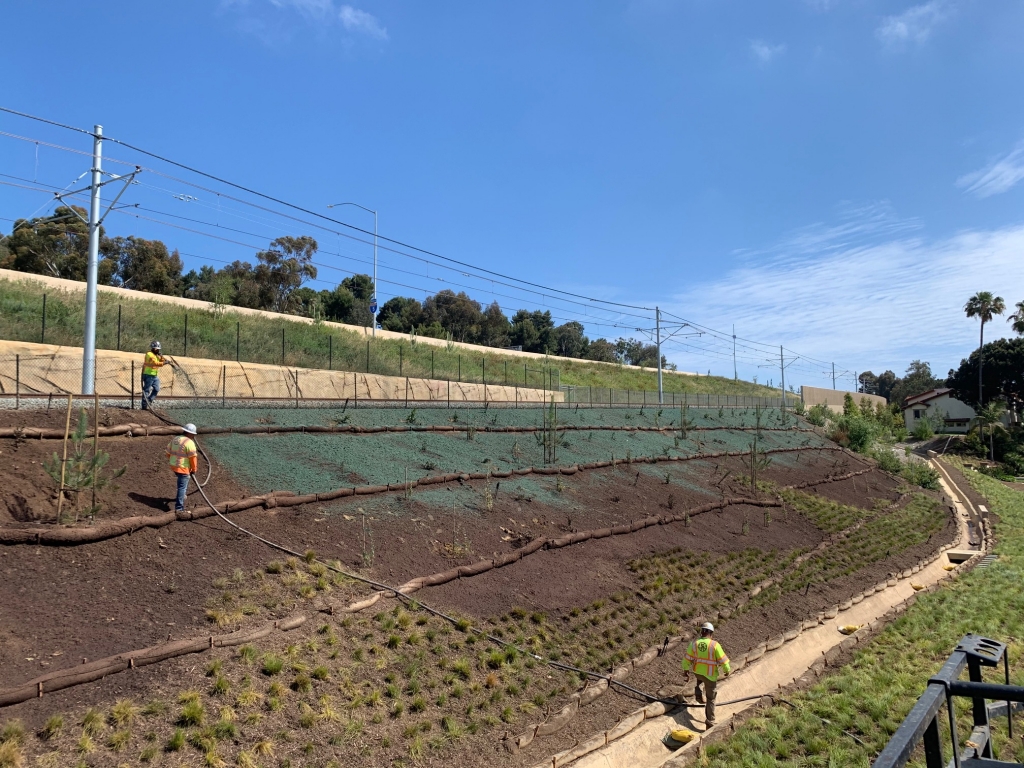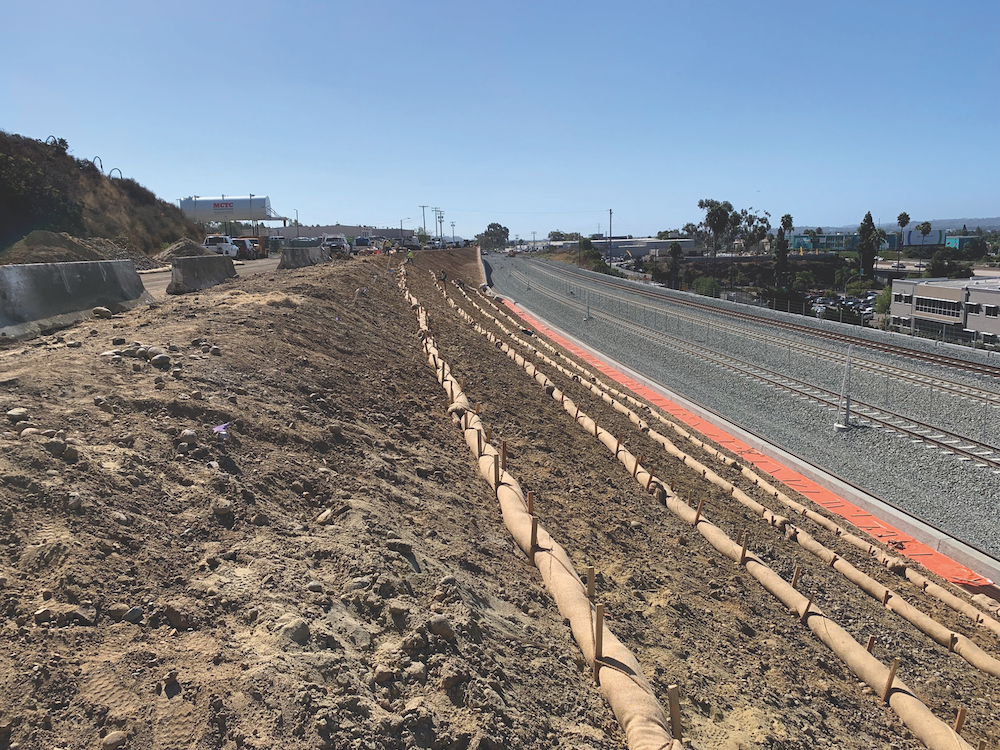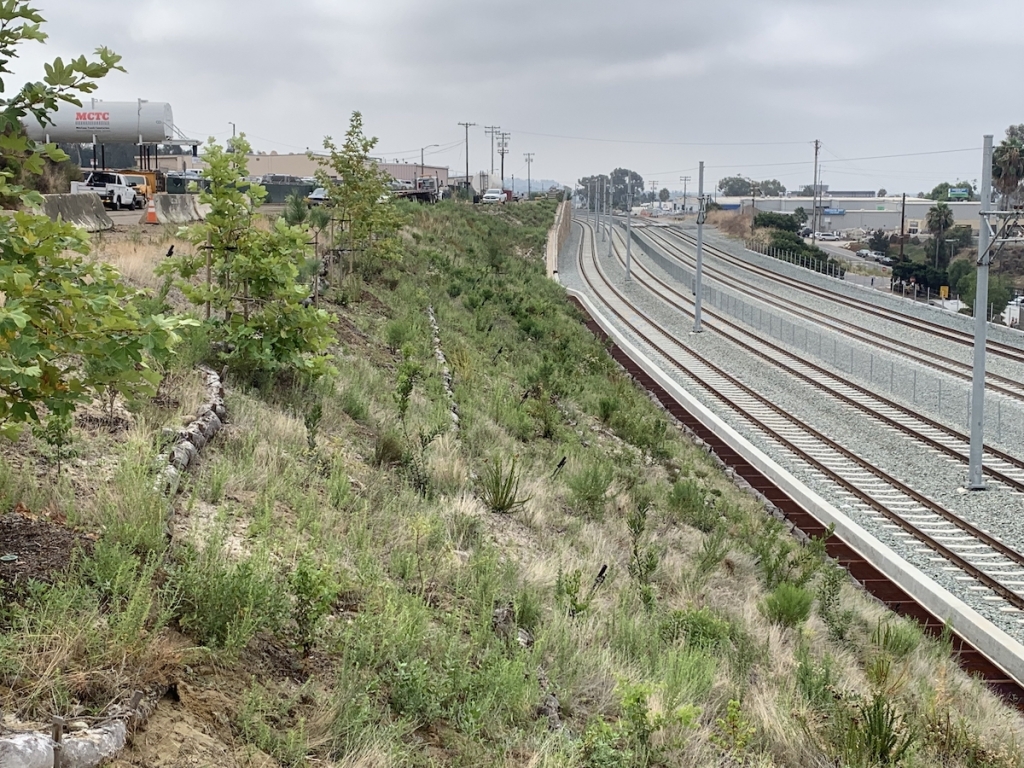Hydroseeding Provides Eco-Friendly Solution on Job Sites (Stormwater: Nov 2021)
 Workers applying the hydraulic erosion control product to the slopes along the railway. Workers applying the hydraulic erosion control product to the slopes along the railway. |
When working on an erosion and sediment control project, ensuring the job gets done right is more important than taking shortcuts to save a dollar or two. Failed projects can mean expensive repairs, delays to construction schedules and can severely harm a contractor’s reputation.
While the success of a project is important on the job site, there are other factors that also need to be taken into consideration — such as safety and environmental impact. Contractors that choose to hydroseed with hydraulically applied soil amendments and erosion control products can easily incorporate these factors into their revegetation plan.
A series of recent railway projects in California illustrate this use of hydroseeding. The San Diego Association of Governments (SANDAG) needed to add additional tracks to the railway to accommodate for growth in the second busiest intercity passenger rail corridor in the nation, the LOSSAN Corridor. These extension projects included the Mid-Coast Transit Corridor project (MCTC), an 11-mile extension of the San Diego Trolley that would operate within the right-of-way of the Metropolitan Transit System (MTS), the San Diego River Double Track and the Elvira to Morena Double Track — while each of which were adding a second main track in their portions of the MTS. To complete these projects, the MCTC Joint Venture (MCTC-JV), a civil construction partnership consisting of companies Skanska, Stacy and Witbeck Inc., and Herzog Railroad Services, needed to earn a Notice of Termination, which requires revegetation efforts along the newly constructed railways.
 The progression of work along the railway started with a slope prepped for application. The progression of work along the railway started with a slope prepped for application. |
There were several ways the group could fulfill this requirement: to control erosion, the contractor could install erosion control blankets or use hydraulically applied erosion control products (HECPs); to amend the soil, contractors could truck in compost or use soil amendments. To better understand all options available to them, MCTC-JV met with erosion control and revegetation professionals to develop a solution that would work on the first try.
Local soil tests showed less than 5 percent organic matter, indicating that the site’s soil needed to be amended to promote seed germination, vegetation establishment and sustainable growth. After consultation, MCTC-JV chose to hydroseed the area with an Engineered Soil Media™ (ESM) and an HECP. MCTC-JV determined this method would yield the results they were looking for. Plus, the hydraulically applied products would keep pace with construction schedules, keep workers out of harm’s way along the railroad and be a more environmentally friendly solution.
Considering Cost-Efficient Effectiveness
These projects are part of a larger, years-long effort to improve the area’s entire metropolitan railway. If one piece of the project falls off schedule, the delay could be detrimental to the whole project.
MCTC-JV worked with Diversified Landscape Co. as the contractor on the site to hydraulically apply an ESM — a growing media designed to help soils reach their fullest potential for vegetative establishment and long-term erosion control by introducing organic components that the soil may be lacking.
|
|
ESMs can also be installed more quickly than traditional compost or topsoil. For example, to install a hydraulic soil amendment using a hydroseeder on one acre of a site, only two tank loads of product applied at 5,000 pounds per acre are necessary. This provides the same amount of organic and soil-building components as 36 truckloads of topsoil or compost, improving the efficiency of the application. Diversified Landscape applied ProGanics® Biotic Soil Media across the sites at 4,000-5,000 pounds per acre using a 3,300-gallon hydroseeder to provide the organic matter and biological components that would establish the vegetation the sites required. ProGanics is a compost and topsoil alternative that accelerates the development of depleted soils and substrates with low organic matter, low nutrient levels or limited biological activity.
Diversified Landscape also saved time on the project sites by hydraulically applying Flexterra® High Performance-Flexible Growth Medium® as an HECP. Based on real world testing, Flexterra has an erosion control effectiveness greater than 99 percent.
During the projects, there were times when railways were authorized to shut down, and work had to be completed within a short time frame and on schedule to avoid delays. Hydroseeding proved to be a time-saving method that helped to keep work within these tight shutdown windows.
Considering Safety
These projects also had an added layer of safety measures that needed to be considered. When working along a railway, there are specific foul zones where work must stop within 25 feet of the tracks while trains are passing through. Because the project area had such a high amount of trail traffic, there were several trains and work stoppages during each normal shift. With such high traffic, safety had to be a high priority for all workers and train passengers.
This need for safety further reinforced MCTC-JV’s decision to use a hydroseeder, as it greatly cut down on the amount of time and labor it took to apply. By being able to limit the number of people on the sites, it kept worker traffic to a minimum. Installing erosion control blankets would have meant bringing in more workers to install the product in a comparable time frame, and trucking in compost would have meant shutting down a portion of the interstate for multiple trucks to safely access the site. Not to mention, all those trucks would have to safely navigate passenger traffic. In contrast, Diversified Landscape only needed one or two hydroseeding trucks to fully apply the soil amendment and erosion control product.
Considering the Environment
With regulations in place to encourage environmentally friendly erosion and sediment control solutions, including the Clean Water Act and the National Pollution Discharge Elimination System, contractors need to take the environment into consideration more than ever before. On these railway projects located near sensitive waterways, the environment was extremely important.
The hydraulically applied products used on these sites were made from recycled wood and were completely biodegradable, non-toxic and safe for the most sensitive environments. As an erosion control product, HECPs don’t have plastic nettings, threads or staples to endanger wildlife like many erosion control blankets do.
For comparison, every acre of double-netted blankets contains more than 11,000 water bottles worth of plastic and up to 263 pounds of metal staples. By using a sustainable, hydraulically applied solution, Diversified Landscape only introduced natural products into the environment. Because HECPs can be applied with fewer trucks, this choice also reduced the overall carbon footprint of the project.
How It All Adds Up
To receive the Notice of Termination, MCTC-JV needed to reduce the projects’ disturbed soil area by proving through site photographs that final stabilization was achieved utilizing 70 percent uniform vegetative coverage under the Statewide Construction General Permit to achieve compliance.
While construction is still underway and a request for Notice of Termination won’t be filed until the construction is complete, there is little doubt the site will achieve its Notice of Termination.
Based on areas where construction is complete and the sites have been seeded, the vegetative cover is already lush and has unofficially achieved 70 percent cover. Photos from the sites show a variety of plant species blanketing the ground. MCTC-JV is highly confident that when the Notice of Termination is filed, it will be accepted. By planning ahead, the site was set up for success from the start.
“The overall results were outstanding,” said Gregg Weed, erosion control manager at Diversified Landscape “The revegetation efforts were very successful. We owe a large part of that to hydroseeding and product selection that increased germination and promoted vegetation establishment. Many of the areas hydroseeded were also landscaped using native container plants. We feel the products and installation improved the successful establishment of these as well.”
MCTC-JV achieved superior results to reach their ultimate goal of securing a project success. Along the way, they were also able to keep their workers and railway passengers safe and applied an environmentally friendly solution.
Original article written by Adam Dibble and Daniel Reynaga for Stormwater Magazine. View the online version.
 The work area today includes substantial vegetative coverage.
The work area today includes substantial vegetative coverage.
